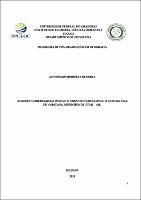| ???jsp.display-item.social.title??? |


|
Please use this identifier to cite or link to this item:
https://tede.ufam.edu.br/handle/tede/6462| ???metadata.dc.type???: | Dissertação |
| Title: | As redes comerciais da pesca e o urbano no amazonas: o caso da Vila de Copatana, município de Jutaí – AM |
| ???metadata.dc.creator???: | Bezerra, Janderson Meireles  |
| ???metadata.dc.contributor.advisor1???: | Schor, Tatiana |
| ???metadata.dc.description.resumo???: | A Amazônia de forma geral, em termos de ocupação humana, é conhecida como um vazio demográfico, mas sabe-se hoje que esse discurso não procede. Existem registros históricos que comprovam que a Amazônia sempre foi ocupada por povos que viviam na região. As várzeas amazônicas eram tão povoadas que estes povos migravam para povoar o resto do continente Sul- Americano, como afirma Fausto (2010, p. 31) "De sua várzea, tão rica quanto disputada por uma população sempre crescente, teriam partido levas migratórias que iriam povoar a América do Sul". Neste contexto imaginário de "vazio demográfico" nos chama a atenção o processo contemporâneo de urbanização a qual este bioma se insere. Neste processo ressaltam-se as Vilas no Alto Solimões/Amazonas com população total acima de mil habitantes. Neste trabalho trataremos sobre a Vila de Copatana, localizada na microrregião do Alto Solimões/Amazonas pertencente ao município de Jutaí. A região possui a agricultura como principal fonte de renda, contudo, foi pelo viés da pesca que melhor conseguimos descrever as relações existentes entre a cidade e a Vila. Neste sentido, o trabalho teve como principal objetivo compreender por meio das redes comerciais de pesca o papel da Vila de Copatana na estruturação da rede urbana da microrregião do Alto Solimões/Amazonas. Para alcançar tal objetivo, foi de suma importância a implantação de um monitoramento foi uma das opções que pensamos e realizamos como uma das formas de colher dados primários, neste caso, de pesca. O monitoramento foi inspirado nos trabalhos de Van-Vliet et al. (2015) e Tavares-Pinto (2015), ambos realizaram suas pesquisas sobre as redes de caça de animais selvagens na tríplice fronteira Brasil-Peru-Colômbia. Devido à quase inexistência de dados secundários específicos para o local os trabalhos de campo realizados na Vila de Copatana foram cruciais para a pesquisa e o entendimento dos processos que ocorrem. Ao final da pesquisa chegou-se à conclusão de que a rede comercial da pesca e o urbano no Amazonas está totalmente interligado desde a Vila de Copatana, no município de Jutaí, às cidades como Tabatinga e Manaus ou outras cidades fora do estado e do país por meio de diversas redes comerciais de pesca. |
| Abstract: | The Amazon in general, in terms of human occupation, is known as a demographic void, but it is known today that this discourse does not proceed. There are historical records that prove that the Amazon was always occupied by people who lived in the region. The Amazonian floodplains were so populated that these peoples migrated to populate the rest of the South American continent, as Fausto states (2010, 31). "From their floodplains, as rich as they were fought by an ever-growing population, would have led to migratory waves that would populate the South America¨. In this imaginary context of "demographic", we are struck by the contemporary process of urbanization to which this biome belongs. In this process the Vilas in Alto Solimões / Amazonas, with a total population of more than 1.000 inhabitants. In this work we will deal with the Copatana Village, located in the Alto Solimões / Amazonas microregion belonging to the municipality of Jutaí. The region has agriculture as the main source of income, however, it was the fishing bias that best describes the relationship between the city and the village. In this sense, the main objective of this work was to understand, through commercial fishing networks, the role of Copatana Village in the structuring of the urban network of the Alto Solimões / Amazonas microregion. In order to achieve this objective, it was extremely important to implement monitoring. This was one of the options we thought and carried out as one of the ways of collecting primary data, in this case, fishing. Tracking was inspired in the works of VanVliet et al. (2015) and TavaresPinto (2015), both conducted their research on wild animal hunting networks on the Brazil- Peru-Colombia triple border. Due to the lack of specific secondary data for the site, the field work carried out in the town of Copatana was crucial for the research and understanding of the processes that occur. At the end of the research, it was concluded that the commercial fishing network and the urban network in Amazonas are totally interconnected from the town of Copatana, in the municipality of Jutaí, to cities like Tabatinga and Manaus or other cities outside the state and the country through commercial fishing networks. |
| Keywords: | Rede Urbana Alto Solimões, Amazonas Vila de Copatana Redes de pesca Urban Network Copatana Village Fishing nets |
| ???metadata.dc.subject.cnpq???: | CIÊNCIAS HUMANAS: GEOGRAFIA |
| Language: | por |
| ???metadata.dc.publisher.country???: | Brasil |
| Publisher: | Universidade Federal do Amazonas |
| ???metadata.dc.publisher.initials???: | UFAM |
| ???metadata.dc.publisher.department???: | Instituto de Filosofia, Ciências Humanas e Sociais |
| ???metadata.dc.publisher.program???: | Programa de Pós-graduação em Geografia |
| Citation: | BEZERRA, Janderson Meileres. As redes comerciais da pesca e o urbano no amazonas: o caso da Vila de Copatana, município de Jutaí – AM. 2018. 140 f. Dissertação (Mestrado em Geografia) - Universidade Federal do Amazonas, Manaus, 2018. |
| ???metadata.dc.rights???: | Acesso Aberto |
| ???metadata.dc.rights.uri???: | http://creativecommons.org/licenses/by-nc-nd/4.0/ |
| URI: | https://tede.ufam.edu.br/handle/tede/6462 |
| Issue Date: | 23-Feb-2018 |
| Appears in Collections: | Mestrado em Geografia |
Files in This Item:
| File | Description | Size | Format | |
|---|---|---|---|---|
| Dissetação_Janderson Bezerra.pdf | 8.42 MB | Adobe PDF |  Download/Open Preview |
This item is licensed under a Creative Commons License





